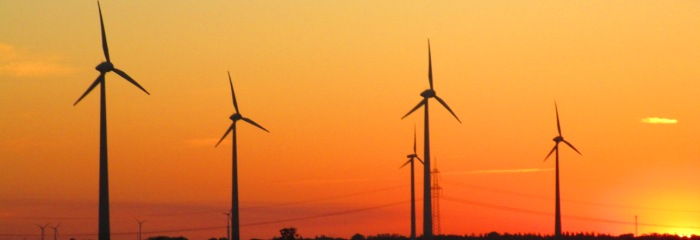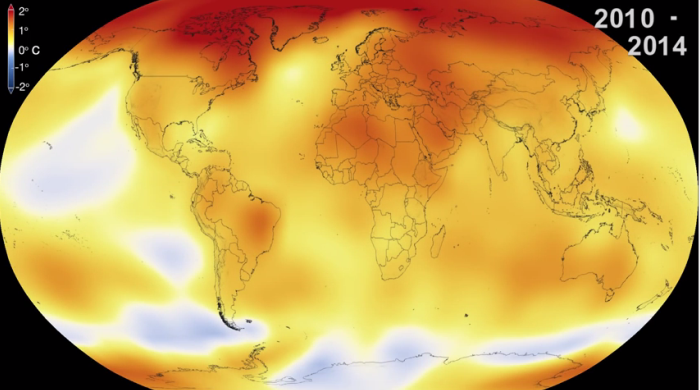Climate change, 2°C target and “decarbonization”
Why business and civil society must act from now
Three things first:
- Carbon is the basis of all life on Earth,
- Carbon dioxide is the main greenhouse gas that prevents the cooling of the earth, creates life-friendly temperatures and thereby allows the current form of life on this planet,
- the proper dosage is a fine line between life and non-life
Ever since the 3rd Assessment Report of the “Intergovernmental Panel on Climate Change” of the UN (IPCC) in 2001, it is clear that the current concentration of CO2 in the atmosphere (2015: more than 400 parts per million) is the highest rate since 15 million years. Of course it has already been significantly higher before but: that was another world.
15 million years long up in the 1860 years the concentration was stable at an average of 280 parts per million. Since the 1960 years it is well known that the man-made industrialization – and almost exclusively through the use of fossil fuels (coal, oil, gas) – is responsible for huge increase in the CO2 content in the atmosphere and thus for most of the global temperature increase. This currently stands at 0.8 °C above the pre-industrial value.

What does the 2°C target mean?
Quite clearly: the limitation to a maximum of 2°C warming by 2050 (ie only 1.2°C difference from the current state) is a purely arbitrary determination to pursue a goal, that the policy makers could agree on. This arbitrary objective has been incorporated as a basis for negotiations in more and more UN climate conferences since Rio in 1992. And important to observe:
even if we meet the 2° target the world will permanently be different from today.
Issued in May 2015 by the Helsinki Sustainability Center their “Manifesto For A Sustainable Planet” describes 6 important parameters that characterize this 2°C target:
- a 2°C higher average temperature climate historian date at times more than 5 million years ago, as the entire Arctic and the West Antarctic ice sheet were ice-free,
- to reach the 2°C target efforts and resolute action are required which seem politically and technically hardly feasible by previous experience,
- global coal, oil and gas industry can comfortably get return on their investments over several decades more and therefore delay a rapid change in the field of energy,
- the entire global economy infrastructure has been built and feedstock is geared for further processing on fossil fuels,
- it is no way around a change in the global economy and
- any hesitation worsens the situation. Business as usual leads to a temperature increase of 4-5 degrees over the next 150 years. This is then a world in which no 9 billion people could live.
What are the consequences of a higher by 2°C average temperature?
- Over a period of several decades initially decreases the sea ice in the Arctic. Thus, a large part of the solar radiation is not reflected but absorbed by the darker sea surface. This speeds immediately the global increase in average temperature.
- A higher average temperature ensures the melting of the permafrost soil in the northern latitudes of the earth even in deeper layers. This escape significant amounts of 20 times stronger greenhouse gas methane uncontrollably out of the ground, which was bound there by the ice. The consequence is a further acceleration of global warming, even if CO2 would effectively reduced.
- Weather extremes will be observed worldwide to an extent with immediate risk of food production and the economic basis of all people being incalculable. The consequences are immense migration because of the deprivation of livelihood for hundreds of millions of people.
- Over a period of several centuries, finally the ice from the Greenland mainland is melting completely and flows as freshwater into the Arctic Ocean. At the same time the ice on the West Antarctic mainland begins to melt. Unlike floating ice this melt increases the volume of the seawater. This combined with a stretch of water by larger cache temperatures raises world sea levels by up to 6m compared to today and affects then immediately the livelihoods of billions of people who live in coastal regions.
- The salt concentration in the oceans decreases with yet unforeseeable consequences for the maritime world. At the same time the Gulf Stream is breaking through the meltwater from Greenland, which affects the European weather. This results a drop in temperature regionally in Europe, although the average global temperature rises. The consequences are migration from the north to the south.
What efforts are needed to meet the 2°C target?
Immense efforts. This is mainly because since Rio 92 on a global political level nothing essential has been moved and simultaneously the dependence on fossil fuels has continued to expand successively and worldwide with partly substantial government subsidies. In the Mainau Declaration 2015 from 03/07/2015 at the end of the 65th Lindau Nobel Laureate Meetings a total of 36 Nobel Prize winners have appealed to start immediate measures to prevent a “wholesale human tragedy”.
- The German environment minister Barbara Hendricks describes the efforts that way: “Until 2050, EU greenhouse gas emissions shall be reduced by 80 to 95 percent compared to 1990. To this end it has to come to a comprehensive transformation.”
- The transformation includes all aspects of life: for example Energy supply, transport and building sector, agriculture, waste management, urban development, industry as well as commerce, trade and the service sector.
- Decarbonisation in this context means the firm, complete abandonment of fossil fuels as the basis for energy production not only if the resources are running out. This is associated with the change in the infrastructure of the global economy.
- Diversion of investment in renewable energy sources, because investment is no longer worthwhile in fossil fuels
- Measures to reduce the CO2 concentration in the atmosphere must be taken beyond reduction in CO2 emissions, eg on the enhanced global plant biomass.
We have another 35 years time and we will thus see the consequences of our actions. Only with superhuman efforts inhumane living conditions can be prevented.

Source: NASA | Allocation of the average global temperature of 2010 to 2014 | 2° have already been reached in the Arctic

